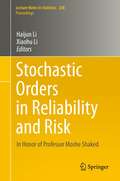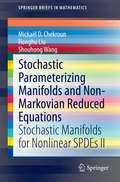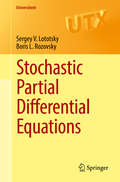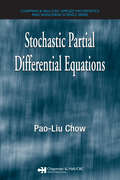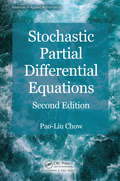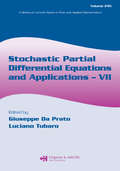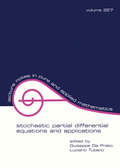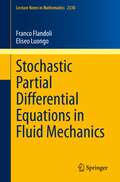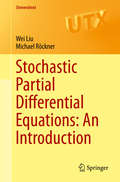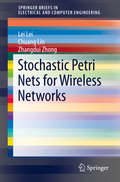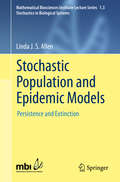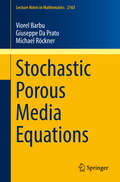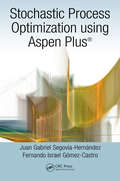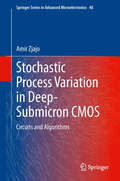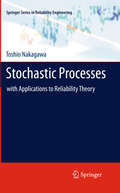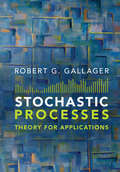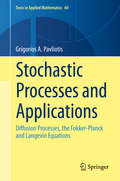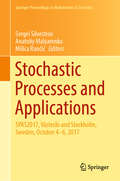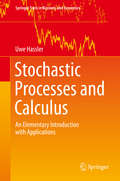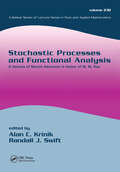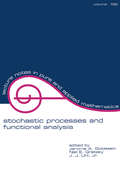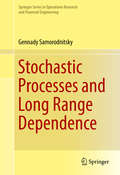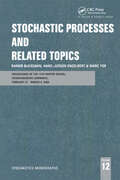- Table View
- List View
Stochastic Orders in Reliability and Risk: In Honor of Professor Moshe Shaked
by Xiaohu Li Haijun LiStochastic Orders in Reliability and Risk Management is composed of 19 contributions on the theory of stochastic orders, stochastic comparison of order statistics, stochastic orders in reliability and risk analysis, and applications. These review/exploratory chapters present recent and current research on stochastic orders reported at the International Workshop on Stochastic Orders in Reliability and Risk Management, or SORR2011, which took place in the City Hotel, Xiamen, China, from June 27 to June 29, 2011. The conference's talks and invited contributions also represent the celebration of Professor Moshe Shaked, who has made comprehensive, fundamental contributions to the theory of stochastic orders and its applications in reliability, queueing modeling, operations research, economics and risk analysis. This volume is in honor of Professor Moshe Shaked. The work presented in this volume represents active research on stochastic orders and multivariate dependence, and exemplifies close collaborations between scholars working in different fields. The Xiamen Workshop and this volume seek to revive the community workshop tradition on stochastic orders and dependence and strengthen research collaboration, while honoring the work of a distinguished scholar.
Stochastic Parameterizing Manifolds and Non-Markovian Reduced Equations
by Mickaël D. Chekroun Honghu Liu Shouhong WangIn this second volume, a general approach is developed to provide approximate parameterizations of the "small" scales by the "large" ones for a broad class of stochastic partial differential equations (SPDEs). This is accomplished via the concept of parameterizing manifolds (PMs), which are stochastic manifolds that improve, for a given realization of the noise, in mean square error the partial knowledge of the full SPDE solution when compared to its projection onto some resolved modes. Backward-forward systems are designed to give access to such PMs in practice. The key idea consists of representing the modes with high wave numbers as a pullback limit depending on the time-history of the modes with low wave numbers. Non-Markovian stochastic reduced systems are then derived based on such a PM approach. The reduced systems take the form of stochastic differential equations involving random coefficients that convey memory effects. The theory is illustrated on a stochastic Burgers-type equation.
Stochastic Partial Differential Equations
by Sergey V. Lototsky Boris L. RozovskyTaking readers with a basic knowledge of probability and real analysis to the frontiers of a very active research discipline, this textbook provides all the necessary background from functional analysis and the theory of PDEs. It covers the main types of equations (elliptic, hyperbolic and parabolic) and discusses different types of random forcing. The objective is to give the reader the necessary tools to understand the proofs of existing theorems about SPDEs (from other sources) and perhaps even to formulate and prove a few new ones. Most of the material could be covered in about 40 hours of lectures, as long as not too much time is spent on the general discussion of stochastic analysis in infinite dimensions. As the subject of SPDEs is currently making the transition from the research level to that of a graduate or even undergraduate course, the book attempts to present enough exercise material to fill potential exams and homework assignments. Exercises appear throughout and are usually directly connected to the material discussed at a particular place in the text. The questions usually ask to verify something, so that the reader already knows the answer and, if pressed for time, can move on. Accordingly, no solutions are provided, but there are often hints on how to proceed. The book will be of interest to everybody working in the area of stochastic analysis, from beginning graduate students to experts in the field.
Stochastic Partial Differential Equations
by Pao-Liu ChowAs a relatively new area in mathematics, stochastic partial differential equations (PDEs) are still at a tender age and have not yet received much attention in the mathematical community. Filling the void of an introductory text in the field, Stochastic Partial Differential Equations introduces PDEs to students familiar with basic probability theor
Stochastic Partial Differential Equations
by Pao-Liu ChowExplore Theory and Techniques to Solve Physical, Biological, and Financial Problems Since the first edition was published, there has been a surge of interest in stochastic partial differential equations (PDEs) driven by the Levy type of noise. Stochastic Partial Differential Equations, Second Edition incorporates these recent developments and impro
Stochastic Partial Differential Equations and Applications - VII (Lecture Notes in Pure and Applied Mathematics)
by Giuseppe Da Prato Luciand TubaraStochastic Partial Differential Equations and Applications gives an overview of current state-of-the-art stochastic PDEs in several fields, such as filtering theory, stochastic quantization, quantum probability, and mathematical finance. Featuring contributions from leading expert participants at an international conference on the subject, this boo
Stochastic Partial Differential Equations and Applications: Proceedings Of A Conference Held In Trento, Italy, September 30 - October 5 1985 (Lecture Notes in Pure and Applied Mathematics #227)
by Giuseppe Da Prato Luciano TubaroBased on the proceedings of the International Conference on Stochastic Partial Differential Equations and Applications-V held in Trento, Italy, this illuminating reference presents applications in filtering theory, stochastic quantization, quantum probability, and mathematical finance and identifies paths for future research in the field.Stochastic Partial Differential Equations and Applications analyzes recent developments in the study of quantum random fields, control theory, white noise, and fluid dynamics. It presents precise conditions for nontrivial and well-defined scattering, new Gaussian noise terms, models depicting the asymptotic behavior of evolution equations, and solutions to filtering dilemmas in signal processing.With contributions from more than 40 leading experts in the field, Stochastic Partial Differential Equations and Applications is an excellent resource for pure and applied mathematicians; numerical analysts; mathematical physicists; geometers; economists; probabilists; computer scientists; control, electrical, and electronics engineers; and upper-level undergraduate and graduate students in these disciplines.
Stochastic Partial Differential Equations and Related Fields: In Honor of Michael Röckner SPDERF, Bielefeld, Germany, October 10 -14, 2016 (Springer Proceedings in Mathematics & Statistics #229)
by Martin Grothaus Andreas Eberle Walter Hoh Moritz Kassmann Wilhelm Stannat Gerald TrutnauThis Festschrift contains five research surveys and thirty-four shorter contributions by participants of the conference ''Stochastic Partial Differential Equations and Related Fields'' hosted by the Faculty of Mathematics at Bielefeld University, October 10–14, 2016. The conference, attended by more than 140 participants, including PostDocs and PhD students, was held both to honor Michael Röckner's contributions to the field on the occasion of his 60th birthday and to bring together leading scientists and young researchers to present the current state of the art and promising future developments.Each article introduces a well-described field related to Stochastic Partial Differential Equations and Stochastic Analysis in general. In particular, the longer surveys focus on Dirichlet forms and Potential theory, the analysis of Kolmogorov operators, Fokker–Planck equations in Hilbert spaces, the theory of variational solutions to stochastic partial differential equations, singular stochastic partial differential equations and their applications in mathematical physics, as well as on the theory of regularity structures and paracontrolled distributions.The numerous research surveys make the volume especially useful for graduate students and researchers who wish to start work in the above-mentioned areas, or who want to be informed about the current state of the art.
Stochastic Partial Differential Equations in Fluid Mechanics (Lecture Notes in Mathematics #2328)
by Franco Flandoli Eliseo LuongoThis book is devoted to stochastic Navier–Stokes equations and more generally to stochasticity in fluid mechanics. The two opening chapters describe basic material about the existence and uniqueness of solutions: first in the case of additive noise treated pathwise and then in the case of state-dependent noise. The main mathematical techniques of these two chapters are known and given in detail for using the book as a reference for advanced courses. By contrast, the third and fourth chapters describe new material that has been developed in very recent years or in works now in preparation. The new material deals with transport-type noise, its origin, and its consequences on dissipation and well-posedness properties. Finally, the last chapter is devoted to the physical intuition behind the stochastic modeling presented in the book, giving great attention to the question of the origin of noise in connection with small-scale turbulence, its mathematical form, and its consequences on large-scale properties of a fluid.
Stochastic Partial Differential Equations: An Introduction
by Wei Liu Michael RöcknerThis book provides an introduction to the theory of stochastic partial differential equations (SPDEs) of evolutionary type. SPDEs are one of the main research directions in probability theory with several wide ranging applications. Many types of dynamics with stochastic influence in nature or man-made complex systems can be modelled by such equations. The theory of SPDEs is based both on the theory of deterministic partial differential equations, as well as on modern stochastic analysis. Whilst this volume mainly follows the 'variational approach', it also contains a short account on the 'semigroup (or mild solution) approach'. In particular, the volume contains a complete presentation of the main existence and uniqueness results in the case of locally monotone coefficients. Various types of generalized coercivity conditions are shown to guarantee non-explosion, but also a systematic approach to treat SPDEs with explosion in finite time is developed. It is, so far, the only book where the latter and the 'locally monotone case' is presented in a detailed and complete way for SPDEs. The extension to this more general framework for SPDEs, for example, in comparison to the well-known case of globally monotone coefficients, substantially widens the applicability of the results. In addition, it leads to a unified approach and to simplified proofs in many classical examples. These include a large number of SPDEs not covered by the 'globally monotone case', such as, for exa mple, stochastic Burgers or stochastic 2D and 3D Navier-Stokes equations, stochastic Cahn-Hilliard equations and stochastic surface growth models. To keep the book self-contained and prerequisites low, necessary results about SDEs in finite dimensions are also included with complete proofs as well as a chapter on stochastic integration on Hilbert spaces. Further fundamentals (for example, a detailed account on the Yamada-Watanabe theorem in infinite dimensions) used in the book have added proofs in the appendix. The book can be used as a textbook for a one-year graduate course.
Stochastic Petri Nets for Wireless Networks
by Chuang Lin Lei Lei Zhangdui ZhongThis SpringerBrief presents research in the application of Stochastic Petri Nets (SPN) to the performance evaluation of wireless networks under bursty traffic. It covers typical Quality-of-Service performance metrics such as mean throughput, average delay and packet dropping probability. Along with an introduction of SPN basics, the authors introduce the key motivation and challenges of using SPN to analyze the resource sharing performance in wireless networks. The authors explain two powerful modeling techniques that treat the well-known state space explosion problem: model decomposition and iteration, and model aggregation using stochastic high-level petri nets. The first technique assists in performance analysis of opportunistic scheduling, Device-to-Device communications with full frequency reuse and partial frequency reuse. The second technique is used to formulate a wireless channel mode for cross-layer performance analysis in OFDM system. Stochastic Petri Nets for Wireless Networks reveals useful insights for the design of radio resource management algorithms and a new line of thinking for the performance evaluation of future wireless networks. This material is valuable as a reference for researchers and professionals working in wireless networks and for advanced-level students studying wireless technologies in electrical engineering or computer science.
Stochastic Population and Epidemic Models
by Linda J. S. AllenThis monograph provides a summary of the basic theory of branching processes for single-type and multi-type processes. Classic examples of population and epidemic models illustrate the probability of population or epidemic extinction obtained from the theory of branching processes. The first chapter develops the branching process theory, while in the second chapter two applications to population and epidemic processes of single-type branching process theory are explored. The last two chapters present multi-type branching process applications to epidemic models, and then continuous-time and continuous-state branching processes with applications. In addition, several MATLAB programs for simulating stochastic sample paths are provided in an Appendix. These notes originated as part of a lecture series on Stochastics in Biological Systems at the Mathematical Biosciences Institute in Ohio, USA. Professor Linda Allen is a Paul Whitfield Horn Professor of Mathematics in the Department of Mathematics and Statistics at Texas Tech University, USA.
Stochastic Porous Media Equations
by Viorel Barbu Giuseppe Da Prato Michael RöcknerFocusing on stochastic porous media equations, this book places an emphasis on existence theorems, asymptotic behavior and ergodic properties of the associated transition semigroup. Stochastic perturbations of the porous media equation have reviously been considered by physicists, but rigorous mathematical existence results have only recently been found. The porous media equation models a number of different physical phenomena, including the flow of an ideal gas and the diffusion of a compressible fluid through porous media, and also thermal propagation in plasma and plasma radiation. Another important application is to a model of the standard self-organized criticality process, called the "sand-pile model" or the "Bak-Tang-Wiesenfeld model". The book will be of interest to PhD students and researchers in mathematics, physics and biology.
Stochastic Process Optimization using Aspen Plus®
by Juan Gabriel Segovia-Hernández Fernando Israel Gómez-CastroStochastic Process Optimization using Aspen® Plus Bookshop Category: Chemical Engineering Optimization can be simply defined as "choosing the best alternative among a set of feasible options". In all the engineering areas, optimization has a wide range of applications, due to the high number of decisions involved in an engineering environment. Chemical engineering, and particularly process engineering, is not an exception; thus stochastic methods are a good option to solve optimization problems for the complex process engineering models. In this book, the combined use of the modular simulator Aspen® Plus and stochastic optimization methods, codified in MATLAB, is presented. Some basic concepts of optimization are first presented, then, strategies to use the simulator linked with the optimization algorithm are shown. Finally, examples of application for process engineering are discussed. The reader will learn how to link the process simulator Aspen® Plus and stochastic optimization algorithms to solve process design problems. They will gain ability to perform multi-objective optimization in several case studies. Key Features: • The book links simulation and optimization through numerical analyses and stochastic optimization techniques • Includes use of examples to illustrate the application of the concepts and specific guidance on the use of software (Aspen® Plus, Excel, MATLB) to set up and solve models representing complex problems. • Illustrates several examples of applications for the linking of simulation and optimization software with other packages for optimization purposes. • Provides specific information on how to implement stochastic optimization with process simulators. • Enable readers to identify practical and economic solutions to problems of industrial relevance, enhancing the safety, operation, environmental, and economic performance of chemical processes.
Stochastic Process Variation in Deep-Submicron CMOS
by Amir ZjajoOne of the most notable features of nanometer scale CMOS technology is the increasing magnitude of variability of the key device parameters affecting performance of integrated circuits. The growth of variability can be attributed to multiple factors, including the difficulty of manufacturing control, the emergence of new systematic variation-generating mechanisms, and most importantly, the increase in atomic-scale randomness, where device operation must be described as a stochastic process. In addition to wide-sense stationary stochastic device variability and temperature variation, existence of non-stationary stochastic electrical noise associated with fundamental processes in integrated-circuit devices represents an elementary limit on the performance of electronic circuits. In an attempt to address these issues, Stochastic Process Variation in Deep-Submicron CMOS: Circuits and Algorithms offers unique combination of mathematical treatment of random process variation, electrical noise and temperature and necessary circuit realizations for on-chip monitoring and performance calibration. The associated problems are addressed at various abstraction levels, i. e. circuit level, architecture level and system level. It therefore provides a broad view on the various solutions that have to be used and their possible combination in very effective complementary techniques for both analog/mixed-signal and digital circuits. The feasibility of the described algorithms and built-in circuitry has been verified by measurements from the silicon prototypes fabricated in standard 90 nm and 65 nm CMOS technology.
Stochastic Processes
by Richard F. BassThis comprehensive guide to stochastic processes gives a complete overview of the theory and addresses the most important applications. Pitched at a level accessible to beginning graduate students and researchers from applied disciplines, it is both a course book and a rich resource for individual readers. Subjects covered include Brownian motion, stochastic calculus, stochastic differential equations, Markov processes, weak convergence of processes and semigroup theory. Applications include the Black–Scholes formula for the pricing of derivatives in financial mathematics, the Kalman–Bucy filter used in the US space program and also theoretical applications to partial differential equations and analysis. Short, readable chapters aim for clarity rather than full generality. More than 350 exercises are included to help readers put their new-found knowledge to the test and to prepare them for tackling the research literature.
Stochastic Processes
by Toshio NakagawaReliability theory is of fundamental importance for engineers and managers involved in the manufacture of high-quality products and the design of reliable systems. In order to make sense of the theory, however, and to apply it to real systems, an understanding of the basic stochastic processes is indispensable. As well as providing readers with useful reliability studies and applications, Stochastic Processes also gives a basic treatment of such stochastic processes as: the Poisson process,the renewal process,the Markov chain,the Markov process, andthe Markov renewal process.Many examples are cited from reliability models to show the reader how to apply stochastic processes. Furthermore, Stochastic Processes gives a simple introduction to other stochastic processes such as the cumulative process, the Wiener process, the Brownian motion and reliability applications. Stochastic Processes is suitable for use as a reliability textbook by advanced undergraduate and graduate students. It is also of interest to researchers, engineers and managers who study or practise reliability and maintenance.
Stochastic Processes (The\springer International Series In Engineering And Computer Science Ser. #321)
by Robert G. GallagerStochastic processes are found in probabilistic systems that evolve with time. Discrete stochastic processes change by only integer time steps (for some time scale), or are characterized by discrete occurrences at arbitrary times. Discrete Stochastic Processes helps the reader develop the understanding and intuition necessary to apply stochastic process theory in engineering, science and operations research. The book approaches the subject via many simple examples which build insight into the structure of stochastic processes and the general effect of these phenomena in real systems. The book presents mathematical ideas without recourse to measure theory, using only minimal mathematical analysis. In the proofs and explanations, clarity is favored over formal rigor, and simplicity over generality. Numerous examples are given to show how results fail to hold when all the conditions are not satisfied. Audience: An excellent textbook for a graduate level course in engineering and operations research. Also an invaluable reference for all those requiring a deeper understanding of the subject.
Stochastic Processes and Applications
by Grigorios A. PavliotisThis book presents various results and techniques from the theory of stochastic processes that are useful in the study of stochastic problems in the natural sciences. The main focus is analytical methods, although numerical methods and statistical inference methodologies for studying diffusion processes are also presented. The goal is the development of techniques that are applicable to a wide variety of stochastic models that appear in physics, chemistry and other natural sciences. Applications such as stochastic resonance, Brownian motion in periodic potentials and Brownian motors are studied and the connection between diffusion processes and time-dependent statistical mechanics is elucidated. The book contains a large number of illustrations, examples, and exercises. It will be useful for graduate-level courses on stochastic processes for students in applied mathematics, physics and engineering. Many of the topics covered in this book (reversible diffusions, convergence to equilibrium for diffusion processes, inference methods for stochastic differential equations, derivation of the generalized Langevin equation, exit time problems) cannot be easily found in textbook form and will be useful to both researchers and students interested in the applications of stochastic processes.
Stochastic Processes and Applications: SPAS2017, Västerås and Stockholm, Sweden, October 4-6, 2017 (Springer Proceedings in Mathematics & Statistics #271)
by Anatoliy Malyarenko Sergei Silvestrov Milica RančićThis book highlights the latest advances in stochastic processes, probability theory, mathematical statistics, engineering mathematics and algebraic structures, focusing on mathematical models, structures, concepts, problems and computational methods and algorithms important in modern technology, engineering and natural sciences applications.It comprises selected, high-quality, refereed contributions from various large research communities in modern stochastic processes, algebraic structures and their interplay and applications. The chapters cover both theory and applications, illustrated by numerous figures, schemes, algorithms, tables and research results to help readers understand the material and develop new mathematical methods, concepts and computing applications in the future. Presenting new methods and results, reviews of cutting-edge research, and open problems and directions for future research, the book serves as a source of inspiration for a broad spectrum of researchers and research students in probability theory and mathematical statistics, applied algebraic structures, applied mathematics and other areas of mathematics and applications of mathematics.The book is based on selected contributions presented at the International Conference on “Stochastic Processes and Algebraic Structures – From Theory Towards Applications” (SPAS2017) to mark Professor Dmitrii Silvestrov’s 70th birthday and his 50 years of fruitful service to mathematics, education and international cooperation, which was held at Mälardalen University in Västerås and Stockholm University, Sweden, in October 2017.
Stochastic Processes and Calculus
by Uwe HasslerThis textbook gives a comprehensive introduction to stochastic processes and calculus in the fields of finance and economics, more specifically mathematical finance and time series econometrics. Over the past decades stochastic calculus and processes have gained great importance, because they play a decisive role in the modeling of financial markets and as a basis for modern time series econometrics. Mathematical theory is applied to solve stochastic differential equations and to derive limiting results for statistical inference on nonstationary processes. This introduction is elementary and rigorous at the same time. On the one hand it gives a basic and illustrative presentation of the relevant topics without using many technical derivations. On the other hand many of the procedures are presented at a technically advanced level: for a thorough understanding, they are to be proven. In order to meet both requirements jointly, the present book is equipped with a lot of challenging problems at the end of each chapter as well as with the corresponding detailed solutions. Thus the virtual text - augmented with more than 60 basic examples and 40 illustrative figures - is rather easy to read while a part of the technical arguments is transferred to the exercise problems and their solutions.
Stochastic Processes and Functional Analysis: A Volume of Recent Advances in Honor of M. M. Rao (Lecture Notes In Pure And Applied Mathematics Ser. #Vol. 238)
by Randall J. Swift Alan C. KrinikThis extraordinary compilation is an expansion of the recent American Mathematical Society Special Session celebrating M. M. Rao's distinguished career and includes most of the presented papers as well as ancillary contributions from session invitees. This book shows the effectiveness of abstract analysis for solving fundamental problems of stochas
Stochastic Processes and Functional Analysis: In Celebration of M.m. Rao's 65th Birthday
by Jerome A. Goldstein; Neil E. Gretsky; J.J. Uhl"Covers the areas of modern analysis and probability theory. Presents a collection of papers given at the Festschrift held in honor of the 65 birthday of M. M. Rao, whose prolific published research includes the well-received Marcel Dekker, Inc. books Theory of Orlicz Spaces and Conditional Measures and Applications. Features previously unpublished research articles by a host of internationally recognized scholars."
Stochastic Processes and Long Range Dependence
by Gennady SamorodnitskyThis monograph is a gateway for researchers and graduate students to explore the profound, yet subtle, world of long-range dependence (also known as long memory). The text is organized around the probabilistic properties of stationary processes that are important for determining the presence or absence of long memory. The first few chapters serve as an overview of the general theory of stochastic processes which gives the reader sufficient background, language, and models for the subsequent discussion of long memory. The later chapters devoted to long memory begin with an introduction to the subject along with a brief history of its development, followed by a presentation of what is currently the best known approach, applicable to stationary processes with a finite second moment. The book concludes with a chapter devoted to the author's own, less standard, point of view of long memory as a phase transition, and even includes some novel results. Most of the material in the book has not previously been published in a single self-contained volume, and can be used for a one- or two-semester graduate topics course. It is complete with helpful exercises and an appendix which describes a number of notions and results belonging to the topics used frequently throughout the book, such as topological groups and an overview of the Karamata theorems on regularly varying functions.
Stochastic Processes and Related Topics: Proceedings of the 12th Winter School, Siegmundsburg (Germany), February 27-March 4, 2000
by Marc Yor Hans-Jürgen Engelbert Rainer BuckdahnThis volume comprises selected papers presented at the 12th Winter School on Stochastic Processes and their Applications, which was held in Siegmundsburg, Germany, in March 2000. The contents include Backward Stochastic Differential Equations; Semilinear PDE and SPDE; Arbitrage Theory; Credit Derivatives and Models for Correlated Defaults; Three In
